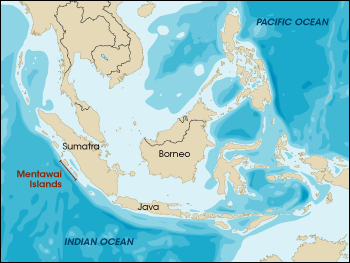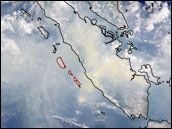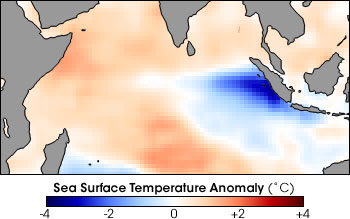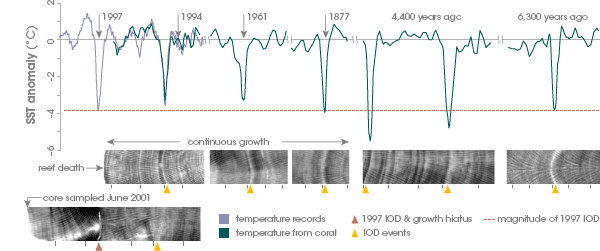

 | |||
In late 1997, cool water from deep in the Indian Ocean was welling up to the surface along the coast of Indonesia. The cool water would have chilled the coral reefs near the Mentawai Islands off the west coast of Sumatra. If corals had a consciousness, however, they wouldn’t have been worried. Over the past 7,000 years, these cold spells had come and gone, and the reefs had barely acknowledged their presence. |
Title photographs copyright Brian Nevins, Saraina Koat Mentawai | ||

Meanwhile, to the east, a strong El Niño was drying out Indonesia’s tropical forests, especially in Borneo and Sulawesi. With rainfall 400-500 millimeters below the annual average, trees would have been slowing down photosynthesis and shedding leaves to prevent water loss. No stranger to El Niño, however, the forest, if it had a consciousness, probably wouldn’t have been too alarmed. It had withstood such droughts before. |
The Mentawai Islands, fringed by coral reefs, lie 160 km (100 miles) off the coast of Sumatra, on the eastern edge of the Indian Ocean. (Map adapted by Robert Simmon) | ||
What happened next, though, is a stunning and heartbreaking example of how human activity superimposed on Earth’s natural cycles of variation can disrupt the dynamic and delicate balance of life and climate. As 1997 became 1998, a sequence of climatic coincidences became a catastrophe when thousands of square kilometers of tropical forests damaged by human impacts went up in flames, indirectly killing almost the entire 400-kilometer Mentawai coral reef system off the coast of Sumatra. Corals Tell a 7,000-year Story of the Indian OceanThe cold water upwelling in the eastern Indian Ocean is part of a climate phenomenon called the Indian Ocean Dipole, during which the eastern half of the ocean becomes much cooler than the western half. Along with these changes in ocean temperature, strong winds blow from east to west at the equator, across Indonesia and the eastern Indian Ocean. The cool ocean temperatures begin to appear south of the island of Java in May and June along with moderate southeasterly winds. Over the next few months, both the winds and cool temperatures intensify and spread northeastward toward the equator. The southeastern Indian Ocean may become as many as 5 to 6 degrees Celsius cooler than the western part. |
 Thick smoke from an unprecedented outbreak of wildfires in Indonesia enveloped the archipelago in late 1997. The smoke was particularly heavy over Sumatra, the large island in the center of this image. The fires were partially to blame for the destruction of the Mentawai Islands’ (outlined in red) coral reefs. This image was acquired on October 29, 1997. (SeaWiFS Image Courtesy Norman Kuring) | ||

The cooling of the ocean in the coastal zone around the Mentawai Islands during Indian Ocean Dipole events influences the circulation of the atmosphere and rainfall, and it’s related to major droughts in Indonesia and Australia and floods in eastern Africa. In 2001, geologist and marine scientist Nerilie Abram was studying the climate history of the Indian Ocean as part of her Ph.D. studies in the School of Earth Sciences at the Australian National University, when she and her colleagues made a surprising discovery: nearly 100 percent of the Mentawai corals were dead! |
Water temperatures around the Mentawai Islands dropped about 4° Celsius during the height of the Indian Ocean Dipole in November of 1997. During these events unusually strong winds from the east push warm surface water towards Africa, allowing cold water to upwell along the Sumatran coast. In this image blue areas are colder than normal, while red areas are warmer than normal. (Image based on data from the IRI/LDEO Climate Data Library) | ||
“Our research group initially started working in the Mentawai Islands because this region is vital in controlling the climate of the Indian Ocean region,” explains Abram. They were planning to use the coral reefs to put together a 7,000-year record of the region’s climate. “As corals grow, the chemistry of their skeletons preserves a detailed record of the environmental conditions.” Because the kinds of chemicals that make it into the corals’ skeletons depend on ocean conditions like salinity and temperature, the chemical composition reflects the ancient climate. Equipped with scuba and snorkeling gear, Abram and her colleagues set out to sea for several months on an Indonesian dive boat. But when they arrived at the Mentawai reefs, she says, “we were surprised to find that the entire reef ecosystem had been killed. By talking to locals and other researchers working in the region we found that the coral and fish in the Mentawai reefs had all been killed when the ocean turned red in 1997, at around the peak of the 1997 Indian Ocean Dipole event.” |

Nerilie Abram and her colleagues discovered the reef death in the Mentawai Islands while sampling corals in an effort to reconstruct past climate. Nearly all of the region’s coral had been dead since 1997, including this lifeless coral being sampled by a diver. (Photograph by Stewart Fallon) | ||
Abram and her research colleagues spent several months collecting samples from the dead corals on the Mentawai reefs. They also collected core samples from fossil corals that were thousands of years old. These ancient corals are fossilized in paleo-reefs around the islands that have been uplifted and preserved by large earthquakes. According to their analysis, the cooling seen during the 1997 dipole event was about 4 degrees Celsius. That’s cool, but not the coldest ever according to Abram’s reef record. Indeed, about 4,400 years before present, the anomaly approached 6 degrees. Even more interesting, none of the numerous episodes of cooling associated with 7,000 years of the ocean’s warm-cool cycle appears to have ever caused such massive reef death. The 1997 event was unique. |

The team drilled cores from fossil reefs along the shoreline, in addition to the recently dead underwater corals. The result was a record of coral growth and ocean temperatures that extended up to 7,000 years ago. (Photograph by Kriton Glenn) | ||
 | |||
Because previous Indian Ocean Dipole events had been colder than the 1997-98 one, the cold water probably wasn’t specifically to blame for the decimation of the Mentawai Reefs, whose productivity provided locals with food and livelihoods and whose beauty attracted tourists and surfers. But the cold water upwelling did play a role in the reefs’ fate. How could a phenomenon that had been coming and going for several thousand years without harm suddenly play a part in something so deadly? The data used in this study are available in one or more of NASA's Earth Science Data Centers. |
Temperature records of the Indian Ocean based on chemical analyses of fossil and modern corals (top) reveal that cold-water events (dips) more severe than the 1997 event have occurred in the past 7,000 years. These dips coincide with changes in coral growth and density that show up in X-ray images of core samples drilled out of the reefs (lined up below graph) as distinct white bands. Unlike the continuous layers of growth (bands) seen in other samples, X-rays of a core sample collected from a modern reef in June 2001 (far left) showed a dramatic break in these regular layers, indicating that reef growth stopped and began again several months later. (Graph by Nerilie Abram) | ||